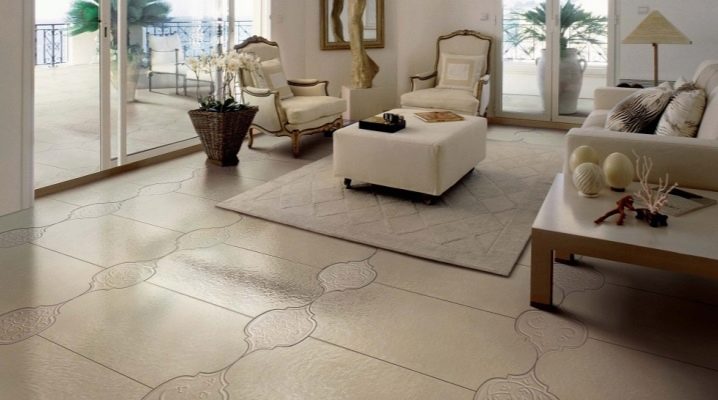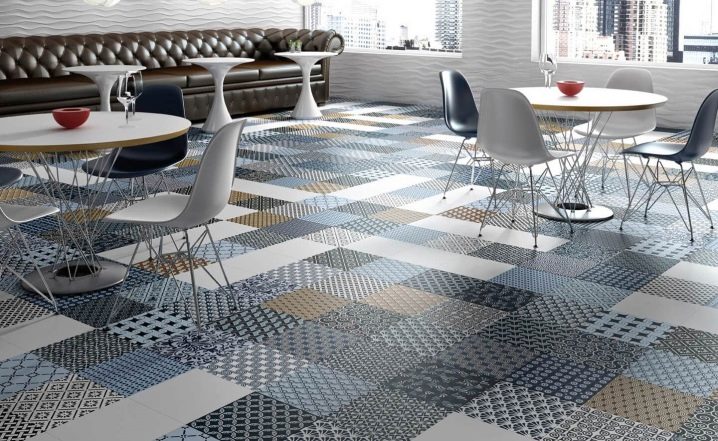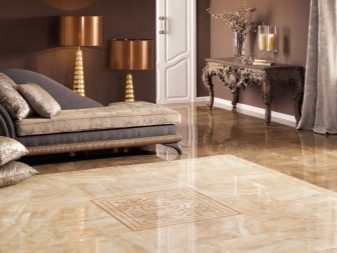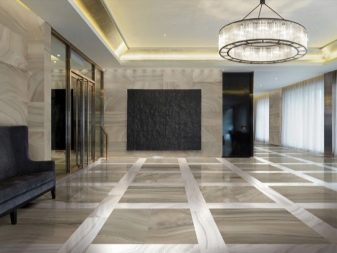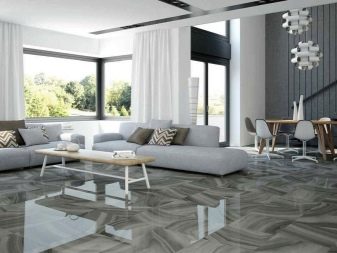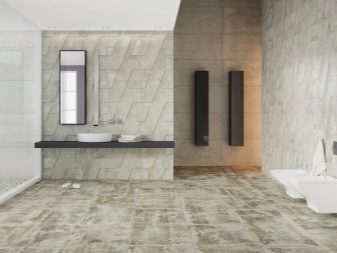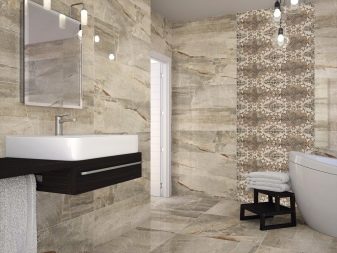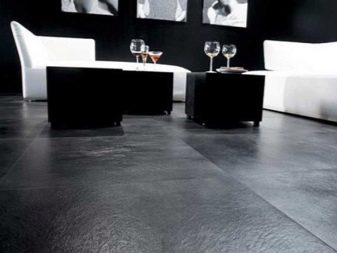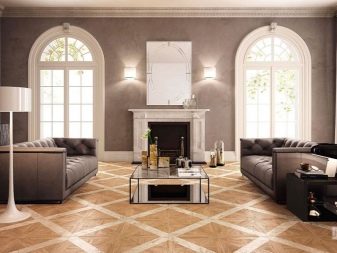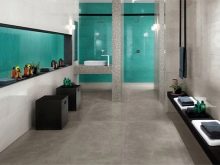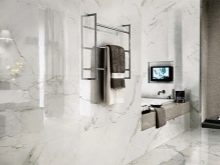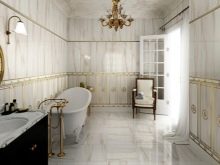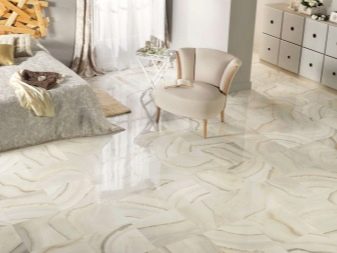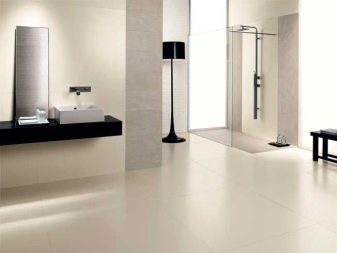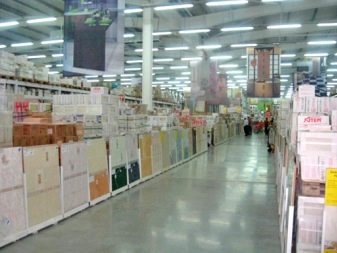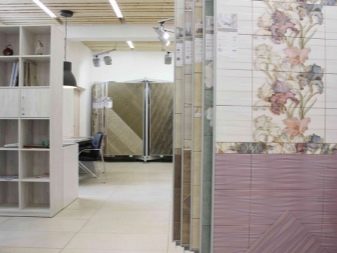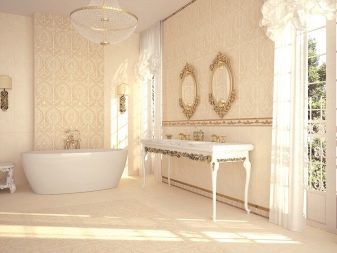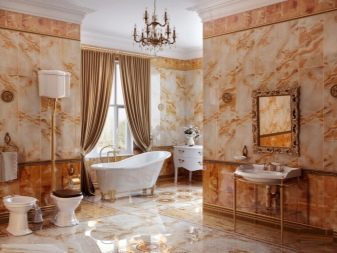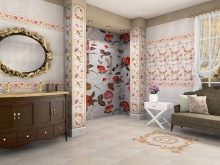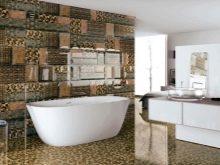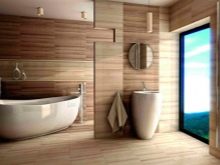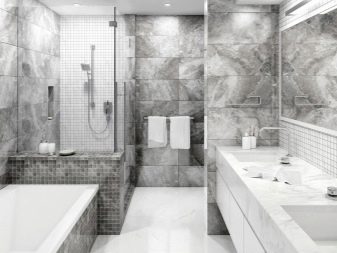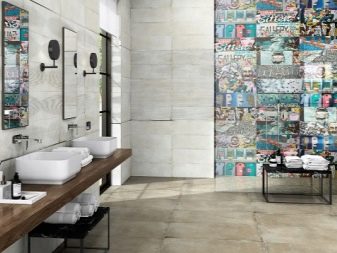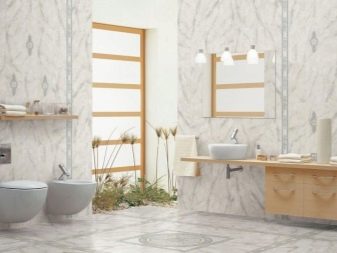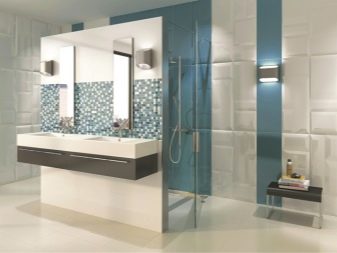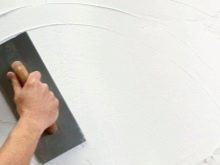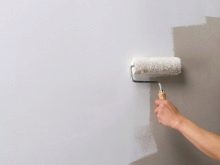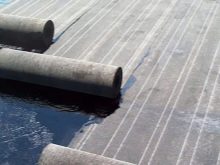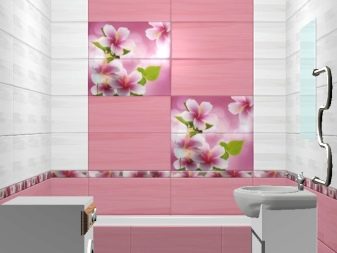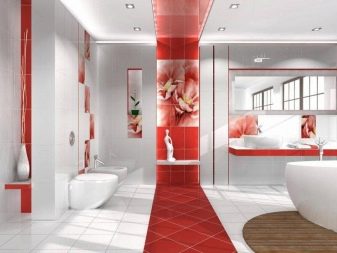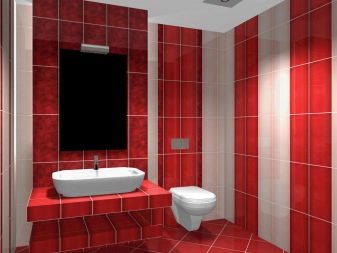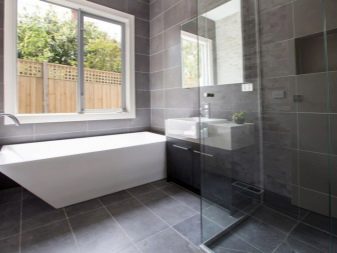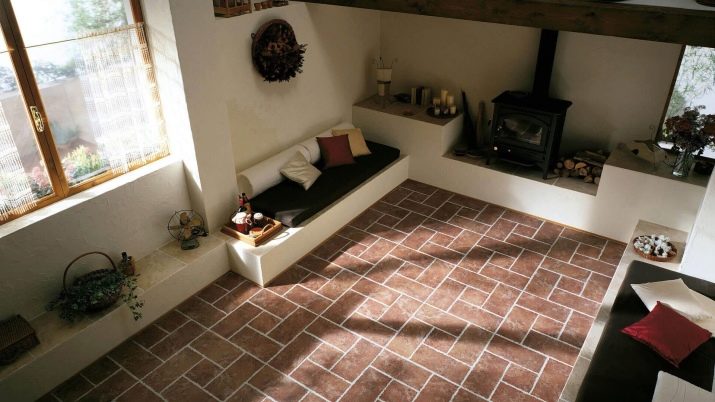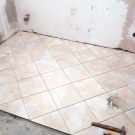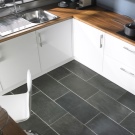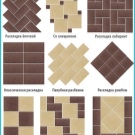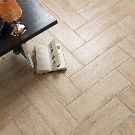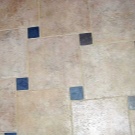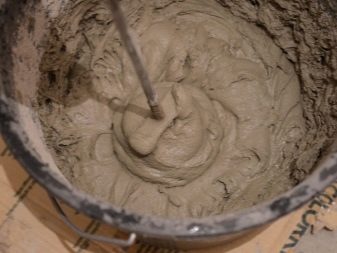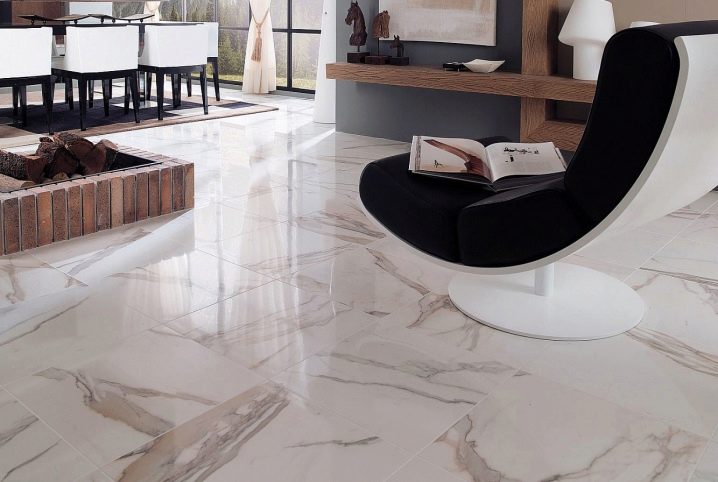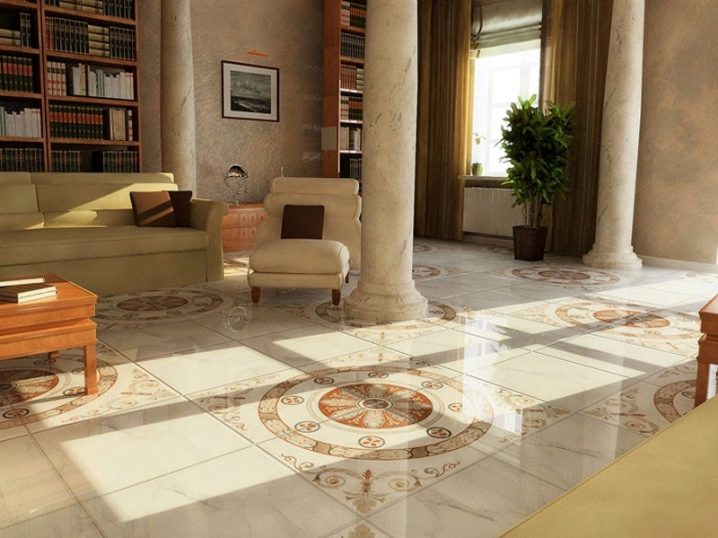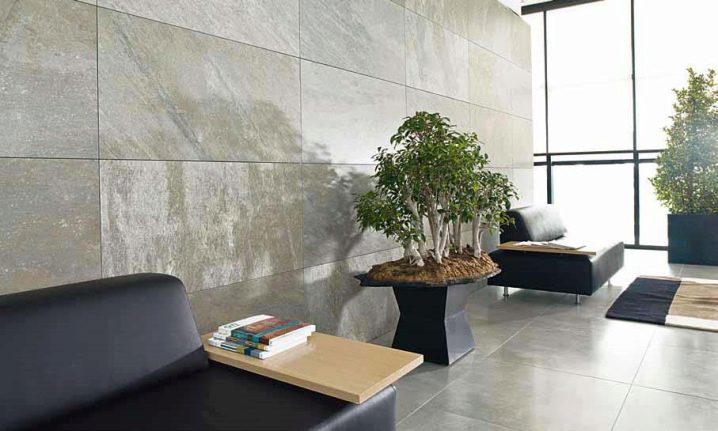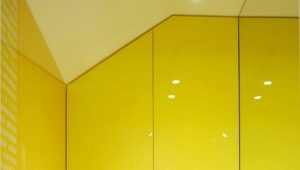Large ceramic tiles in the interior
With the coming into vogue of such interior styles as loft, hi-tech, minimalism and grunge, ceramic tiles and large porcelain tiles gain popularity. Manufacturers of outdoor products create entire collections dedicated to large-format products.
Working on the texture, color, features of the processing of joints, masterpieces are created that can decorate any interior.
Special features
Some time ago, a thick, large tile could be found only in the decoration of industrial premises, at least - in public places with high traffic. However, in the design of their apartments and country houses, people exposed to the trends of fashion trends, are increasingly choosing elite large-format ceramic products as floor coverings.
To understand why such a floor is valued, you should imagine a monolithic shiny surface of a floor with imitation of marble orfrosted plates with an illusion of woody texture that seem to envelop the floor.
So, the advantages of the product:
- external attraction;
- simplified method of installation due to fewer parts;
- creating a fashionable design;
- extensive range of applications: the floor and walls in a house or apartment, cladding of the facade of buildings, paving sidewalks;
- environmental friendliness of the material from which the product is made;
- has a long service life: over the years, does not lose its external and utilitarian properties;
- is a refractory material that prevents the spread of fire during fires;
- not afraid of household chemicals and any cleaning products, does not allow them to penetrate into the base;
- tile easy to operate and clean;
- has antistatic properties: does not attract dust;
- due to its thickness has excellent sound insulation;
- The best material for finishing the bathroom and rooms that suggest a high level of humidity.
However, a large tile has a number of features that may seem negative:
- high price;
- Often, laying the product involves the absence of seams - such filigree work can only be done by a real professional;
- the choice of large-format tiles is related to the size of the room in which it is supposed to be laid.
Thus, the production of large models involves the use of only the highest quality and durable materials, as well as the organization of the process of their direct processing, which is high-tech. Such conditions directly affect the price of finished products. It should be noted that large-format ceramic coatings are also a fashionable trend in the world of interior design.
The above factors automatically convert large tile to the category of elite products. The price of such products at sales points is often indicated not for 1 running meter, but for 1 piece, which indicates a high cost.
You should not choose this method of finishing the floor or walls for those who plan to work in a small room.
In a cramped bathroom or toilet, you will have to cut and adjust the tile a lot, which means spoiling its original idea. Unfortunately, the desired effect can not be achieved, and such repairs will cost a pretty penny.
Options
The tile parameters include values such as length, width, and thickness.All three values in the product depend on each other, since their harmonious relationship allows you to make a high-quality and sturdy product that is not afraid of mechanical effects.
Flooring is usually thicker. In this way, domestic ceramic tile has a thickness of 8-11 mm, imported - 7-10 mm, domestic and imported porcelain - 7.5-12 mm. These parameters should be considered when installing the combined coatings.
In order for the joint of tiles with laminate or parquet to be beautiful, and it could easily be covered with a decorative molding, it is necessary to monitor the level of the base in the process of laying two different coatings, as well as to take into account the thickness of the adhesive and the substrate.
Wall tile more thin. It is not amenable to such a rough impact, as the floor, moreover, it is lighter, since it is located vertically. Typically, the thickness of domestic and import manufacturers ranges from 6 to 7 mm.
The width and length of a large-format tile usually has the following values: 60x120, 75x150, 25x150, 40x120, 30x120, 60x60 and 20x120 cm. These parameters are considered the most popular., although some manufacturers may include unique, exclusive formats in their product line.
Styling details
There are certain requirements for the base on which the installation of ceramic products is directly performed. These requirements are common to tiles of any size.
To satisfy them, it is necessary to perform a number of works:
- Remove existing old decorative coating.
- Rate how the walls and the floor are even. They can be: rough, have slopes in different directions, be convex or concave. You can check the deviations using a special construction level, as well as beacons, which are installed along the edges of the walls.
- You can remove the unevenness with plaster (if the level difference is less than 5 cm) or with the help of drywall. A level drop of less than 1 cm should not be leveled - it will disappear under a layer of tile adhesive and the tile itself.
- Apply a coat of primer.
- For the preparation of the floor should be purchased roll waterproofing, and for the walls - a liquid moisture insulating substance. To make installation and drawing accordingly.
Before proceeding directly to the laying of the tile, it is necessary to clearly define how each element will be located.
Modern lounges with ceramic products offer to create a design project using a special computer program. According to the parameters of the room is chosen the best option pattern laying, which minimizes the need for cutting tiles, and most importantly - will allow you to create a harmonious interior. This program automatically creates a quote that indicates how many packs of tiles are required, and what the final cost will be.
Without such an opportunity, you can also try on your own to find a suitable installation option. To do this, use a long construction ruler and a pencil to draw the location of each product, taking into account also 2-3 mm per seam.
You should not use the old method: put on the corner and cut the final elements. Especially in the case of large-format tiles, this method will simply spoil the whole look of the room.
But the method of laying, in which the composition is built from the center, and the corner tiles are evenly cut off, is optimal. Consumption of finishing material will be more, but for the entire repair the amount of overpayment will not burden anyone.
When creating a room design in which tiles will be coated on the floor or on the walls, it is worth considering which visual technique to choose and how to arrange the elements:
- Vertical rectangular wall tile. This technique is not the most popular, however, vertical stripes can visually lift the architecture of the room - this is true in rooms with low ceilings.
- Horizontal rectangular wall tile. This method expands the room, making it more spacious. This technique is very relevant in modern apartments. They are actively used, creating an interior in small bathrooms and bathrooms.
- Square floor or wall tiles, laid out diagonally. When choosing such a method, you should know that this is the most expensive type of installation, since you have to cut a lot, and the quality of the work depends on the professionalism of the master. You should not do it yourself without experience.
- Tiled brickwork. It creates only a visual effect.
- Laying tiles with decorative elements - panels, borders, "pencils", "beads", "overlays". When using additional inserts, the complexity of the work is increased. It is better to trust the professional master.
Large size tiles need a good glue that can hold a lot of weight. This is especially true in relation to the installation of wall ceramic coatings. Selecting the necessary products, should be selected compounds with a high degree of adhesion (at least 1.5 MPa), fixing abilities, as well as, taking into account the specifics of the room, moisture-proof and independent of temperature differences.
The solution should be applied to the prepared surface of the base with a special notched trowel. Layer thickness should be 3-6 mm. Further, according to the picture, laid tile. To adjust the level of the tile there is 20 minutes before the moment when the glue is bonded.
The finished mixture is considered to be operational no more than 2 hours., after that, its drying takes place, and, as a result, the loss of the necessary properties. The duration of complete drying of the glue is 5-6 days.
If the product assumes the presence of seams, then they must be decorated with a special grout. It is sold in different colors, which are selected either to match the main surface or, on the contrary, in a contrasting color.
On the features of laying a large tile you will learn from the following video.
Beautiful ideas in the interior
Especially impressive large tile looks in the design, made with imitation of marbled. Seamless monolith of dark color, lined with the same technology, it is worth picking up in spacious rooms with lots of light.
Light tile looks solemn and weightless. The glazed shiny surface widens the space advantageously, reflects the sunlight, refreshes the interior.
For classic designs, you can pick up large-format models with decorative panels in the form of panels. The palace styles of baroque, rococo, empire, classicism could not be better supported by such decisions.
Meanwhile, large ceramic products are perfect for minimalist interiors, which the male half like so much. The grungy porcelain stoneware of steel shades is harmoniously combined with furniture from rough leather. However, the game on the contrast is also very relevant, so a small but very soft white carpet can be included in such an interior.
